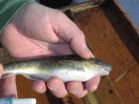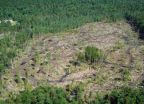(Press-News.org) Fairbanks, ALASKA—Black bears show surprisingly large and previously unobserved decreases in their metabolism during and after hibernation according to a paper by scientists at the Institute of Arctic Biology at the University of Alaska Fairbanks and published in the 18 February issue of the journal Science.
"In general, an animal's metabolism slows to about half for each 10 degree (Celsius) drop in body temperature. Black bears' metabolism slowed by 75 percent, but their core body temperature decreased by only five to six degrees," said Øivind Tøien, IAB research scientist and lead author.
The amount of metabolic suppression was a surprise since the decrease in body temperatures of hibernating bears was moderate. Tøien and colleagues were also surprised when the bears' metabolism remained suppressed for several weeks after the animals emerged from their dens.
Interest in the physiology of human-sized hibernators like black bears extends beyond comparative biology, since application of the mechanisms of metabolic suppression to people in emergency situations could save lives. "Quickly reducing metabolic demand in victims of stroke, heart attack or trauma would put them in a stabilized, protected state to provide more time to arrange advanced, medical care. It could extend the golden hour to a golden day or longer." said Brian Barnes, IAB director and senior author of the paper.
This is the first study to continuously measure the metabolic rates and body temperatures of black bears as they hibernated during the winter under natural conditions and after they emerged from their dens in spring. Technical limitations have previously prevented continuous long-term monitoring of such large animals.
The study included five American black bears, which were nuisance bears captured in south-central and Interior Alaska by the Alaska Department of Fish and Game.
Tøien and colleagues implanted radio transmitters into each bear to record its body temperature, heart beats and muscle activity. The bears were kept in structures mimicking dens, away from human disturbance, and monitored via infrared cameras.
"We measured the bears' metabolism by continuously measuring the oxygen and carbon dioxide concentrations of the air entering and leaving the den," Tøien said The transmitters inside each bear told us that the bear's body temperature was not stable, but varied over the winter in slow cycles each lasting several days."
"Such large, multi-day fluctuations in core body temperature are unlike those observed in any other mammal before. This detail was missed by past studies, and may have caused overestimation of metabolic rate because bears periodically shiver when they increase their body temperature," Tøien said.
Hibernating bears only breathe one to two times per minute and their heart slows between breaths; sometimes there is 20 seconds between beats. "Each time the bear takes a breath, the heart accelerates for a short time to almost that of a resting bear in summer," said Tøien. "When the bear breathes out, the heart slows down again and there will be another 30 to 60 seconds until the next breath."
Tøien and colleagues had expected to find the animals' metabolism returning to normal levels right away when the bears resumed activity and emerged from their dens in spring just like a small hibernator such as the arctic ground squirrel would do. "We were surprised to find that the bears' metabolic rates were still only about half of their normal, summer levels even though body temperature had returned to near normal of 37°C," Tøien said.
They continued to monitor the bears' metabolism for another month after emergence and observed that it took the bears two to three full weeks to stabilize at their summer metabolic levels. "Free-ranging bears one may encounter out in the woods in early spring may be in a transition state," Tøien said.
Toien, Barnes and collaborators will continue studies to determine the changes in gene expression that accompany transitions in hibernating state in black bears and whether protection of tissues can be activated during the summer.
###
The research has been supported by the National Science Foundation and the office of the US Army Medical Research and Materiel, the National Institutes of Health, gift funds to Stanford University, American Heart Association and the Fulbright Program.
Contact:
Øivind Tøien, research scientist, Institute of Arctic Biology, University of Alaska Fairbanks. 907-474-6843, otoien@alaska.edu.
Brian M. Barnes, professor of zoophysiology, director Institute of Arctic Biology, University of Alaska Fairbanks. 907-474-7648, bmbarnes@alaska.edu
Marie Gilbert, information officer, 907-474-7412, Institute of Arctic Biology, University of Alaska Fairbanks, 907-474-7412, megilbert@alaska.edu
Scientists uncover surprising features of bear hibernation
Metabolism independent of body temperature
2011-02-18
ELSE PRESS RELEASES FROM THIS DATE:
Flocculent spiral NGC 2841
2011-02-18
Star formation is one of the most important processes in shaping the Universe; it plays a pivotal role in the evolution of galaxies and it is also in the earliest stages of star formation that planetary systems first appear.
Yet there is still much that astronomers don't understand, such as how do the properties of stellar nurseries vary according to the composition and density of the gas present, and what triggers star formation in the first place? The driving force behind star formation is particularly unclear for a type of galaxy called a flocculent spiral, such as ...
Improving microscopy by following the astronomers' guide star
2011-02-18
A corrective strategy used by astronomers to sharpen images of celestial bodies can now help scientists see with more depth and clarity into the living brain of a mouse. Eric Betzig, a group leader at the Howard Hughes Medical Institute's Janelia Farm Research Campus, will present his team's latest work using adaptive optics for biology at the annual meeting of the American Association for the Advancement of Science in Washington, D.C. during a press conference on Thursday, Feb., 17, and a panel discussion on Friday, Feb. 18.
A key problem in microscopy is that when ...
Plants cloned as seeds
2011-02-18
Plants have for the first time been cloned as seeds. The research by aUC Davis plant scientists and their international collaborators, published Feb. 18 in the journal Science, is a major step towards making hybrid crop plants that can retain favorable traits from generation to generation.
Most successful crop varieties are hybrids, said Simon Chan, assistant professor of plant biology at UC Davis and an author of the paper. But when hybrids go through sexual reproduction, their traits, such as fruit size or frost resistance, get scrambled and may be lost.
"We're ...
Reverse genetics allow scientists to slow the spread of the Rubella virus
2011-02-18
Scientists have identified the gene that allows the Rubella virus to block cell death and reverse engineered a mutant gene that slows the virus's spread. Tom Hobman and a team of researchers at the University of Alberta's Faculty of Medicine and Dentistry believed that RNA viruses were able to spread by blocking the pathways in cells that lead to cell suicide, and isolated the responsible gene in Rubella, also known as German measles. They then created a mutant version of this gene that made the virus spread more slowly. These results are reported in PLoS Pathogens.
The ...
Engineering atomic interfaces for new electronics
2011-02-18
MADISON — Most people cross borders such as doorways or state lines without thinking much about it. Yet not all borders are places of limbo intended only for crossing. Some borders, like those between two materials that are brought together, are dynamic places where special things can happen.
For an electron moving from one material toward the other, this space is where it can join other electrons, which together can create current, magnetism or even light.
A multi-institutional team has made fundamental discoveries at the border regions, called interfaces, between ...
Identification of glaucoma gene brightens view for future therapies
2011-02-18
Glaucoma – a leading cause of vision loss and blindness worldwide – runs in families. A team of investigators from Vanderbilt University and the University of Florida has identified a new candidate gene for the most common form of the eye disorder, primary open angle glaucoma (POAG).
The findings, reported Feb. 17 in the open-access journal PLoS Genetics, offer novel insights into glaucoma pathology and could lead to targeted treatment strategies.
Elevated pressure inside the eye is a strong risk factor for POAG. Pressure increases because of increased resistance to the ...
Checklist cuts lethal ventilator-associated lung infections
2011-02-18
Cases of ventilator-associated pneumonia — the most lethal and among the most common of all hospital-associated infections — dropped by more than 70 percent in Michigan hospitals where medical staff used a simple checklist designed by Johns Hopkins researchers. Such pneumonias kill an estimated 36,000 Americans each year.
The findings, published online in the journal Infection Control and Hospital Epidemiology, show how a relatively simple series of steps, coupled with an education program and a culture that promotes patient safety, can save tens of thousands of lives ...
New Pitt projects will test brain computer interfaces for people with spinal cord injury
2011-02-18
PITTSBURGH, Feb. 17 – Researchers at the University of Pittsburgh have been awarded funding for two projects that will place brain-computer interfaces (BCI) in patients with spinal cord injuries to test if it is possible for them to control external devices, such as a computer cursor or a prosthetic limb, with their thoughts.
The projects build upon ongoing research conducted in epilepsy patients who had the interfaces temporarily placed on their brains and were able to move cursors and play computer games, as well as in monkeys that through interfaces guided a robotic ...
A genetic mutation allows Hudson River fish to adapt to PCBs
2011-02-18
NEW YORK, Feb. 17, 2011 – A research group led by a New York University School of Medicine scientist discovered a genetic variant that allows a fish in the Hudson River to live in waters heavily polluted by PCBs. In a study published in the February 18, 2011, online issue of Science, they report that a population of Hudson River fish apparently evolved rapidly in response to the toxic chemicals, which were first introduced in 1929, and were banned fifty years later. PCBs, or polychlorinated biphenyls, were used in hundreds of industrial and commercial applications, especially ...
Turning forests into fuel: New report outlines promise and limits of biomass energy in the Northeast
2011-02-18
(Millbrook, N.Y. – Feb 17, 2011) Forest biomass could replace as much as one quarter of the liquid fossil fuel now being used for industrial and commercial heating in the Northeastern United States. That's according to a new report released today by the Cary Institute of Ecosystem Studies.
But the report also has sharp caveats: The potential for forest biomass varies widely within the region, and forest resources must be carefully managed to protect the other important services and goods they provide. Under the right circumstances, however, the report found that forest ...
LAST 30 PRESS RELEASES:
How the parasite that ‘gave up sex’ found more hosts – and why its victory won’t last
When is it time to jump? The boiling frog problem of AI use in physics education
Twitter data reveals partisan divide in understanding why pollen season's getting worse
AI is quick but risky for updating old software
Revolutionizing biosecurity: new multi-omics framework to transform invasive species management
From ancient herb to modern medicine: new review unveils the multi-targeted healing potential of Borago officinalis
Building a global scientific community: Biological Diversity Journal announces dual recruitment of Editorial Board and Youth Editorial Board members
Microbes that break down antibiotics help protect ecosystems under drug pollution
Smart biochar that remembers pollutants offers a new way to clean water and recycle biomass
Rice genes matter more than domestication in shaping plant microbiomes
Ticking time bomb: Some farmers report as many as 70 tick encounters over a 6-month period
Turning garden and crop waste into plastics
Scientists discover ‘platypus galaxies’ in the early universe
Seeing thyroid cancer in a new light: when AI meets label-free imaging in the operating room
Neutrophil-to-lymphocyte ratio may aid risk stratification in depressive disorder
2026 Seismological Society of America Annual Meeting
AI-powered ECG analysis offers promising path for early detection of chronic obstructive pulmonary disease, says Mount Sinai researchers
GIMM uncovers flaws in lab-grown heart cells and paves the way for improved treatments
Cracking the evolutionary code of sleep
Medications could help the aging brain cope with surgery, memory impairment
Back pain linked to worse sleep years later in men over 65, according to study
CDC urges ‘shared decision-making’ on some childhood vaccines; many unclear about what that means
New research finds that an ‘equal treatment’ approach to economic opportunity advertising can backfire
Researchers create shape-shifting, self-navigating microparticles
Science army mobilizes to map US soil microbiome
Researchers develop new tools to turn grain crops into biosensors
Do supervised consumption sites bring increased crime? Study suggests that’s a myth
New mass spec innovation could transform research
Maternal nativity, race, and ethnicity and infant mortality in the US
Migration-related trauma among asylum seekers exposed to the migrant protection protocols
[Press-News.org] Scientists uncover surprising features of bear hibernationMetabolism independent of body temperature



